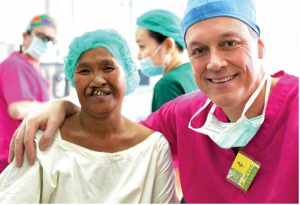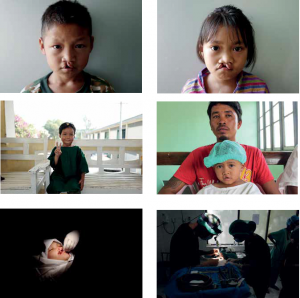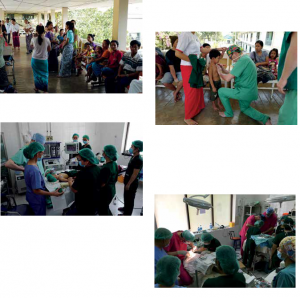
See & Smile is a non-profit organisation that sends out humanitarian missions to underdeveloped regions and Third World countries. These missions are carried out by volunteers, most of whom are health care professionals. Via testimonials from volunteers on a mission to Myanmar, Diplomatic World was able to lift the curtain and give readers a look behind the scenes.
Being one of the long-term members of See & Smile, Dr. Patrick Tonnard has made it a personal mission in life to travel at least once a year in his scarce free-time to hidden places in Asia where medical assistance is poor and not easily accessible for the local population. As a plastic surgeon, his specialty is to operate cleft lips. The engagement and commitment of the Belgian team towards a common goal, might look naive but for the participants it is incredibly emotionally rewarding. The direct impact these doctors create, changes the lives of thousands and thousands of people in Asia and Africa each year. The trip is definitely not a holiday camp. It involves long days of travelling, and operating from early morning to late evening, but the energy the participants get out of it at the end is worth the effort. Apart from the physical effort, the confrontation with the local conditions for living, but also for surviving with only the essentials brings those highly educated doctors with their feet back on the ground. From a philosophical point of view the mission confronts the Belgian team to become humble and modest, to question our materialistic world, facilitating the search for balance and raising questions on how we deal with each other, from one human to the other. The experience with the local Buddhism also helps to digest the trip more easily, reflecting about our ways of being and living. The humanity in one-toone contacts with patients and their family members makes the reward even greater. The attitude of the team goes beyond civic responsibility or moral duty. For the local communities it is even more important, because they feel they are supported. For Patrick’s last mission to Myanmar the 18 person medical team was composed of surgeons specialised in cleft lips and ophthalmologists who carried out corrective eye surgery. A specialised team of anaesthesists, nurses and assistants completed the different members. When man and mind are ready, material and money are the next factors which are indispensable for such an important logistic mission. The involvement and investment of Venerable Bhante Sitagu Sayadaw, made it possible to travel fast and efficiently to Hpa-An and Oak Pho, north of Yangon. Logistically the steps were well-prepared, and all necessary equipment was shipped via flight cases, to perform in the best possible conditions, which of course can vary depending on the type of destination. Materials and tools for aftercare were also flown in. Part of the mission activates an educational program, oriented to local doctors or nurses. The participating doctors stimulate and push each other in going for a common goal and are inspired by the energy and appreciation of the local communities. Some patients travel for days by foot when they know See & Smile is on its way to a village. People are so warm, calm and patiently wait for their diagnosis and possible operation. This compensates for the fatiguing trip and the incredible rhythm in which the team performs one surgery after the other. In these circumstances it is of the utmost importance that the energy within the group is positive and also guided in the right way.
The team-building aspect of this group, having been on several missions before, deserves an applause. Nobody is obliged to do anything, but when engaging in such an adventure, 200% commitment is necessary to make this sometimes exotic mission a success. The selection of patients is done very fast and almost intuitive. The doctors do not want to take any risks, selecting easy and rapid surgeries. The slightest chance that the after program of care will be too intensive and could bring a medical risk, means the patient will not be operated. From the start the mission has been completely a-political and it is not a political statement on how local ministries, hospitals, organisations or even regimes work. The volunteers are free to come and work and they all engage but none of them has a political agenda when travelling on a mission. The long-term effect of this mission resonates in Myanmar long after Patrick and his group are back to reality in Belgium. The search for funding is a never ending story but the donations the organisation receives from donors and maecenases, or via charity is always the start for the next mission.
THROUGH THE EYES OF THE OPHTHALMOLOGISTS
Early in the morning, a few hours before sunrise, a team of 18 volunteers leaves for Myanmar. After an intense 30-hour journey and a time difference of 5,5 hours we arrive at the hotel in Hpa-An. A quick fresh-up and we immediately go out to explore the remote hospital at Lambwe, an hour from our hotel. All five trunks full of equipment are unpacked and put in the operating room. Two of the four microscopes we were promised have already been hijacked by the local team, but we are confident we can work with one or two as well. The heat and lack of air-conditioning are a bigger nuisance. Still, this cuts back on the costs of operating outfits. Anything other than shorts and we will have to deal with a fainting epidemic amongst our volunteers. Mimi, the local nurse, has coordinated many of these missions; a task she fulfils with brimming enthusiasm. She screens patients and takes care of pre-surgical tests. Prof. Aung, the (supposedly retired) vitreoretinal surgeon is a welcome and regular presence at the hospital. He takes care of the check-ups after surgery and loudly compliments everyone for a job well done. When we are finally at full speed, the mission is paused because of an enormous heat wave. An unfortunate occurrence but there are too many heat stroke incidents with the patients and we would probably soon follow. Since we are unemployed, we decide to make the best of the situation and go play tourist. We are provided with bikes and a very handsome guide and are out exploring. For a few hours at least, because biking in these temperatures is much more exhausting than anticipated. We find a fresh spring to cool off and a nice shadowy terrace with cold drinks. On day 4, we are transferred to Oak Pho, a village 300 km to the north of Yangon. After a draining 12-hour journey we arrive late in the evening. No rest for the motivated and we start the next day with screening around 80 patients, half of whom qualify for cataract surgery. The next few days are a blur spent in the operating room. During this trip we performed surgery on 118 patients and did several laser treatments. We worked hard to help as many people as we possibly could and returned home exhausted. Still, is there a more fulfilling vacation than one spent returning light to the eyes of the blind?
THROUGH THE EYES OF DAPHNE VELGHE, BELGIAN MODEL AND REPORTER
With 50 suitcases and after 30 hours of flying, we arrive at Hpa-An. Severely jetlagged and half sleeping, we are welcomed by eighty-year-old Buddhist monk Sayadaw. He is a very important and respected man and judging by the amount of people who fall to their knees when they see him, he is the equivalent of the pope in Myanmar. It is a great honour to be greeted by him. In less than an hour, the hospital is transformed from its Pearl Harbor state to a modern place with two fully equipped operating rooms. Before we return to our hotel for the evening, we are told that hundreds of patients are already lining up for eye exams. A busy day lies ahead for our ophthalmologists! On day two, hundreds of patients are waiting at the hospital to be treated by the See & Smile team. I try to be of help but am often stopped by patients who want their picture taken with this ‘huge’ human being. A young girl in rainbow pajamas draws my attention. She looks around nervously under the watchful eye of her concerned father. “Can I please take a picture?”, I ask. No reaction; after all English is not widely spoken here. I take my picture in the golden Myanmar light and move on to help somewhere else. A few hours later, the duo is still waiting patiently. She is wearing a sterile shirt so she had to leave her father’s lap. He is on a chair a few feet away, shooting reassuring glances at her. Despite the scorching heat (37 degrees!) and the fact that she is not allowed to eat or drink before the operation, she does not complain. When it is finally her turn to go into the operating room, she looks back at her father nervously. Only 30 minutes later she is done, upper lip fixed. Her father picks her up when she wakes and he starts crying tears of relief and joy. And there I am, four feet away, trying to capture this unique moment. Of course, I am crying too which makes it a tad more difficult than usual. The next day I notice another girl, one who is not shy at all but proudly shows everyone her stuffed animal. She is the life of the waiting room and when she comes up to give me a kiss, I notice she has severe burns all over her neck and body. Her skin transplant will take the plastic surgeons several hours. When the surgeries at Hpa-An are finished, the team prepares to go to another hospital outside of Yangon. The local nurses help pack up our medical equipment and they do so with the greatest precision. They have a very limited access to books and internet and are therefore a bit behind on knowledge. Still, they are determined to catch up and are eager to learn. “That’s the beauty,” says Dr. Patrick Tonnard. “You learn something and are able to teach it here to people who are so grateful and willing to learn. The satisfaction I get from my work here, is unlike anything I have ever experienced back in Belgium.” The team helped 120 patients in only three days’ time. About sixty of those were blind and got their sight back after an operation of merely 30 minutes. The other half had a cleft lip or palate and received surgery that takes about the same amount of time. It is both beautiful and sad how such a quick operation can change someone’s life so completely. I spoke to several patients about their plans for the future and was pleasantly surprised by how ambitious they were. On the plane back to Belgium after two weeks in Myanmar, I think back on my eye-opening trip. The Burmese way of life was very different from mine, with life and work completely interwoven in a small community. I wonder if I can apply their sense of calm to my own reality; a reality in which there is abundant possibility for superficiality. I arrive home with a suitcase full of memories and experiences and resolve to be thankful for this look at a different way of life.
SEE & SMILE VZW See & Smile is an organisation that sends out humanitarian missions to underdeveloped regions and Third World countries. These missions are carried out by volunteers, most of whom are health care professionals: plastic surgeons, ophthalmologists, anaesthesists, dentists, opticians and nurses. All missions are on a voluntary basis and every participant pays his or her own transport and accommodation. The volunteers choose to use their vacation periods to travel to countries in Africa and Asia – often multiple times per year – where they perform cataract surgeries, reconstruct cleft lips and palates, and do dental treatments. The main activity of our ophthalmologists is the treatment of cataract, a clouding of the lens in the eye which leads to a decrease in vision. Cataract is one of the most common causes of blindness worldwide. By replacing the existing eye lens with an artificial lens through micro surgery, patients are able to regain their sight. In addition to cataract, other eye diseases like glaucoma and eye infections are detected and treated. They also hand out free glasses after giving eye exams to get people their customized prescription and help as many as they can. The main activity for our plastic surgeons is treatment of cleft lip or palate. This handicap is one of the most common congenital facial abnormalities. Cleft lip and/ or palate is a separation of the parts or segments of the lip or roof of the mouth, which are usually joined together during the early weeks in the development of an unborn child. In Belgium, nearly all patients with a cleft lip or palate undergo surgery at a very young age. The lip is treated at the age of four to six months, while the palate is treated at age 1,5. Unfortunately, in most underdeveloped countries this care is unavailable and children are forced to grow up with severe facial deformities of the lip and palate. See & Smile pays for the necessary medication, medical instruments and anaesthesia equipment; all of which is donated to the region after the volunteers leave. They also invest in the training of local doctors and local health care workers. Some are offered the opportunity to follow specialized courses in Belgium. They also fund the building of local hospitals whenever the local infrastructure is insufficient. Every year, 10.000 people are examined during the See & Smile missions, of which 1.200 children and adults undergo surgery. www.seeandsmile.com





